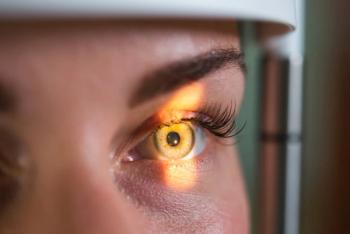
- January/February digital edition 2025
- Volume 17
- Issue 01
Routine electroretinography use supports patient management
In 2023, we made the decision to do better for our patients who have diabetes by integrating electroretinography (ERG) in our 5 clinics. We viewed the investment as a necessary step in elevating the level of care we provide. Before adding ERG, our functional assessments were subjective and relied on patient performance and feedback, leaving room for error and poor or unreliable data. We were drawn to a handheld device because it is practical and provides objective, actionable information. After performing 1,500 tests, we discovered that it is useful across multiple pathologies, including optic neuritis.
Updated practice protocol
Our ERG protocol has evolved. We began by making the decision to obtain a diabetic retinopathy (DR) score on every patient who has diabetes. The goal was to test these patients annually or more often depending upon the level of severity or presence of retinopathy.This protocol applies whether the patient has diabetic retinopathy or is newly diagnosed with diabetes. The goal for us is to obtain a baseline exam.We make it standard of care in our practice because we believe it is in the best interest of our patients.
In addition to utilizing the DR score, we routinely use the RETeval device’s photopic negative response (PhNR) protocol to measure ganglion function and aid and support diagnosis, management, and treatment of optic nerve neuropathies, including glaucoma. Finally, we now also perform the Flicker 16 protocol on all macular pathologies, including drusen.
What we really love about the RETeval device is the portability. In our clinics, we see a relatively high volume of patients, which means we don’t have the luxury of slowing down. Space is also a concern. Many of our instruments take up a full workup testing room. For example, our other subjective test—the visual field—needs to be carefully orchestrated because we can accommodate only 1 patient in the room at a time. This portable electroretinography (ERG) device can be used in the exam room after the workup, which works seamlessly with our general flow.
Optic neuritis case report: Patient history
An established patient presented for a comprehensive exam in 2023. This 70-year-old white female had a family history of diabetes, hypertension, and cancer. She was also positive for multiple sclerosis, thyroid dysfunction, and high cholesterol. More than 10 years ago, she had an episode of optic neuritis in her left eye. Interestingly, relative to her multiple sclerosis, she says she was told that she no longer needed treatment, nor did she need to be seen by neurology. This concerned us given what the Optic Neuritis Treatment Trial tells us about the high likelihood of recurrence in optic neuritis in patients with a history of diagnosis of multiple sclerosis.1-3
Findings
The patient’s best corrected vision in the left eye was hand motion. Her vision in the right eye was 20/20. She had mentioned previously that she had a family history of legal blindness, which was somewhat poorly defined; she mentioned glaucoma, cataracts, and degenerative disorders of the macula.
The fundus exam showed asymmetry of the optic nerves in terms of pallor (OS>OD) as well as mild cupping and drusen in both eyes (Figure 1). We performed visual field testing, but the patient routinely failed the visual field testing based on high fixation losses, which greatly underscores the value of an objective functional test.The best visual field index we had seen was 21%.
Optical coherence tomography (OCT) showed mild drusen and macular thickening OD and poor fixation and a significant epiretinal membrane OS (Figure 2). Given the patient’s inability to focus on a target straight ahead due to poor vision, even our OCT findings were limited. Fortunately, at this more recent visit, we were able to perform a baseline ERG. We thought this would be helpful for a couple of different reasons. First, due to the history of optic neuritis, we wanted to be able to have a functional assessment of the retina comparing the right eye to the left eye. Also, because the patient has a macular pathology (drusen), we want to be ultra protective of the vision in the right eye. We had recently instituted a drusen protocol that prompted the technician to proceed with a Flicker 16 test. Although this was not the most useful protocol (PhNR is preferred in this case), it helped provide clarification given the difficulty we were having capturing actionable detail using other tests.
The results of the Flicker 16 protocol (Figure 3) show the right eye implicit time and amplitude are within normal limits. The left eye implicit time is significantly outside normal limits and the amplitude is reduced. These results indicate the presence of cellular stress due to a retinal pathology.
Treatment
We are now seeing this patient more frequently to monitor drusen and optic neuritis recurrence. She is scheduled back in 6 months, at which time we will perform the PhNR test. We also advised the patient to use an AREDS supplement. We also encouraged the patient to continue to see neurology, but if she does not, at least we are doing what we can to fill that void.
References
Volpe NJ. The optic neuritis treatment trial: a definitive answer and profound impact with unexpected results. Arch Ophthalmol. 2008;126(7):996-999. doi:10.1001/archopht.126.7.996
Pirko I, Blauwet LA, Lesnick TG, Weinshenker BG. The natural history of recurrent optic neuritis. Arch Neurol. 2004;61(9):1401-1405. doi:10.1001/archneur.61.9.1401
Graves J, Balcer LJ. Eye disorders in patients with multiple sclerosis: natural history and management. Clin Ophthalmol. 2010;4:1409-1422. doi:10.2147/OPTH.S6383
Articles in this issue
10 months ago
Education should be current, relevant, useful10 months ago
How do GLP-1 receptor agonists affect ocular health?10 months ago
Debunking myths about keratoconusNewsletter
Want more insights like this? Subscribe to Optometry Times and get clinical pearls and practice tips delivered straight to your inbox.









































